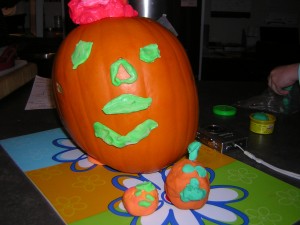Once a pumpkin gets a face, it assumes a “person”ality and emotions. Being able to recognize someone else’s emotions depends on 2 parts; how well #1 person shows that emotion and how well #2 person reads that expression. Children need lots of practice both making all kinds of faces and figuring out what other people’s faces are saying. Putting faces on pumpkins is an ideal time to focus on faces. Yesterday’s blog posts had kids making faces in a mirror. Today’s post is making faces with playdo or plasticine and real pumpkins.
 Set a pumpkin on a table or counter and roll out some face parts using a contrasting color of playdo. Adults may need to help little fingers smoosh the bits onto the pumpkin but they stick quite easily. As long as the pumpkin isn’t too wobbly, kids can steady it with one hand and stick with the other. While this activity is great for such kindergarten readiness skills as fine muscle coordination, planning, stimulating language etc, it also really helps kids with matching feelings and faces. Talk about it with your child and ask what a mouth that’s down might mean, or how a pumpkin shows it’s happy. Experiment with all different sorts of mouths, eyes, and noses.
Set a pumpkin on a table or counter and roll out some face parts using a contrasting color of playdo. Adults may need to help little fingers smoosh the bits onto the pumpkin but they stick quite easily. As long as the pumpkin isn’t too wobbly, kids can steady it with one hand and stick with the other. While this activity is great for such kindergarten readiness skills as fine muscle coordination, planning, stimulating language etc, it also really helps kids with matching feelings and faces. Talk about it with your child and ask what a mouth that’s down might mean, or how a pumpkin shows it’s happy. Experiment with all different sorts of mouths, eyes, and noses.
When children go to kindergarten, they are placed in large groups of kids with usually only 1 or 2 adults. Helping children to develop relationships with other kids will not have the same kind of adult guidance and support as before. One way to prepare them is to practice figuring out what other people are saying with their face. This is tremendously important for relating to others.
Positive relationships are not just important for readiness for kindergarten. Just last month the Bucksbaum Family Foundation donated $42 million for a medical university institute that will focus on improving doctor-patient relationships. Turns out that this relationship can affect people’s health in many ways. Relationships are important. What kind of face is on your pumpkin? Does it look friendly?
